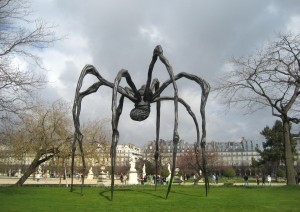June 27th, 2015
A Matter of Life and Death is both awesome and intimate, suggesting that a single tear shed for love might stop heaven in its tracks.- Roger Ebert
A Matter of Life and Death (1946) is a wonderful fantasy movie about an English pilot who’s in love with an American (it was made to boost post-war Anglo-American relationships). It begins with their unique ‘falling’ in love scene (that can be seen here) – the dead pilot argues his case in Heaven to be allowed to return to life. The scenes on Earth are in Technicolor while Heaven is in black and white (which makes it more surreal). The last words are from a Walter Scott poem:
‘For love is heaven and heaven is love.’
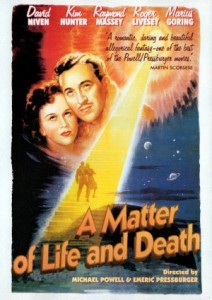
Tags: movies, Universe
Posted in Movies, Universe | No Comments »
June 15th, 2015
At last, a big picture is emerging in science as links have been found between the small and the large, between quantum physics and biology. The poster child of ‘quantum biology’ is the European robin. The bird uses the Earth’s magnetic field to navigate vast distances – but the field is 100 times weaker than a fridge magnet, so how does the robin detect it? It uses an very finely balanced system that reaches from the sub-atomic level to the biological. Here’s how it seems to work: a photon (‘particle’) of light enters the bird’s eye as it’s flying; the photon is absorbed by a protein molecule in the eye where it causes electrons to become ‘entangled’ (an electron state that’s sensitive to magnetic fields); this creates a chemical change in the protein molecule which sends a signal to the bird’s brain telling it which way to fly. This ‘magneto-reception’ occurs in many bird species (including chickens!), honey bees, dolphins, butterflies, sharks, lobsters and stingrays. This fascinating book tells the full story:
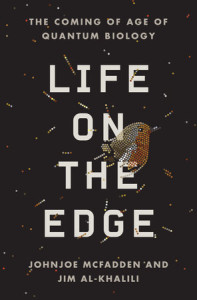
Tags: connections, science
Posted in Science, Universe | No Comments »
May 22nd, 2015
The best picture books are like a marriage: the text and illustrations support each other but have a strong life of their own. For very young children the plot should be focused and the pictures comforting. I Went Walking by Sue Williams is a perfect first book. The words are basic yet they incorporate repetition, questions, rhymes and humour. And the illustrations by Julie Vivas are sublime; leading the eye across the page in a dance of line, shape and colour. (See her gorgeous version of the Nativity too).
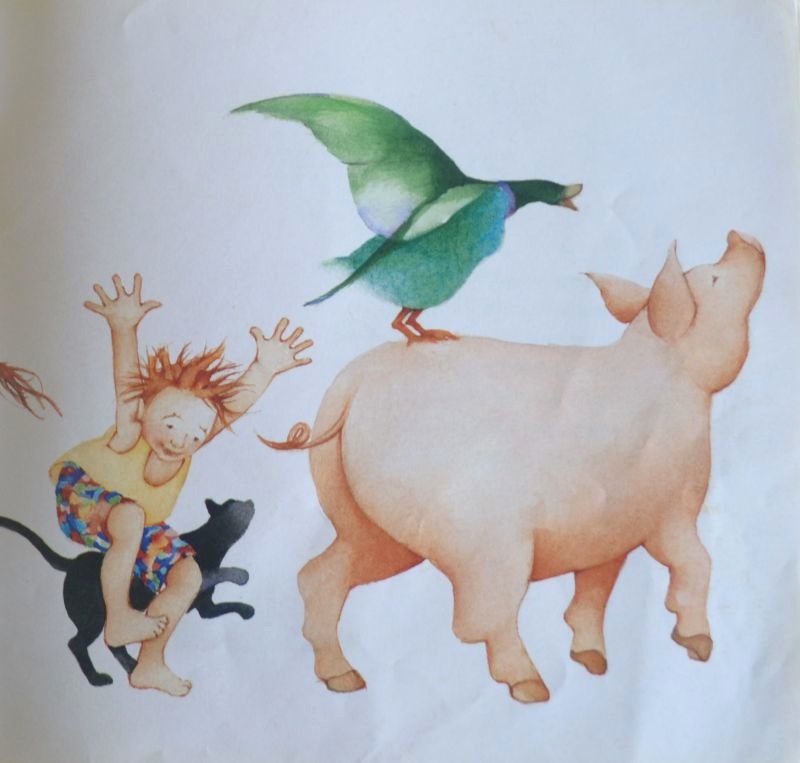
Max’s Bath by Barbro Lindgren is another delightful book for preschoolers. Max dumps his toys and his food in the tub and then tries to wash the dog with predictable results. Max is a classic ‘terrible two year old’ combining charm and mischief.
The picture book Seasons by French artist, Blexbolex is a unique, meditative book for young children that adults will relish for it’s design. It’s a tactile treat, printed in chunky hardback on rough paper, like old comic annuals. Each page has a single word and a subtle image to illustrate it. No garish colours here, just the quiet passing of seasons.
Tags: children's books, picture books
Posted in Book Reviews, Children's Books | No Comments »
May 10th, 2015
Antoine de Saint-Exupéry (1940) is best loved for his exquisite fable The Little Prince, but he also wrote one of the greatest true adventures, Wind, Sand and Stars (1940), an exciting poetic, philosophical memoir. Saint-Exupéry’s flights in the 1920s and 30s took him across the Pyrenees, Andes, and the Sahara in a tiny plane that would sometimes conk-out “with a great rattle like the crash of crockery.” There are remarkable descriptions of flying among waterspouts in a typhoon and his survival after a crash in the desert (which inspired The Little Prince).
In the sky a thousand stars are magnetized, and I lie glued by the swing of the planet to the sand. A different weight brings me back to myself…Behind all seen things lies something vaster; everything is but a path, a portal or a window opening on something other than itself.

Tags: books, reviews
Posted in Book Reviews | 3 Comments »
April 10th, 2015
The first step towards being a writer is to hitch your unconscious mind to your writing arm.– Dorothea Brande
The 1934 classic Becoming a Writer, by Dorothea Brande, is a practical writing book which is also in tune with current neuroscience. Brande wrote that the writer’s unconscious mind should ‘flow freely and richly, bringing at demand all the treasures of memory’ – meanwhile the conscious mind does the hard work to ‘control, combine and discriminate’ words and sentences. Our unconscious is the source of our most original stories but it’s a reluctant creature, resisting the discipline that writing requires. Brande has some intriguing exercises designed to tap into the unconscious:
- Writing immediately after you wake up before any associations invade the mind.
- Writing at a prearranged time every day.
- Moments of meditation and mindfulness.
Brande also says, most importantly I think, that every writer has something unique to offer the world:
There is just one contribution which every one of us can make: we can give into the common pool of experience some comprehension of the world as it looks to each of us.

Tags: consciousness, writing
Posted in Writing | No Comments »
March 5th, 2015
The movie that forever changed my attitude to the future. – Michio Kaku
Forbidden Planet is a classic sci-fi movie about an alien society that has destroyed itself through technology and the scientist, Morbius, who discovers their secret. It shares elements with The Tempest except the movie uses science in place of the supernatural – the great Arthur C. Clarke’s maxim was that any advanced technology is indistinguishable from magic. The film’s science is plausible and the psychology even more so. I love this movie for the brilliant monster from the sub-conscious (designed by Disney animators); its set design; the first ever all-electronic score (by Bebe and Louis Barron); and the melodramatic script:
My evil self is at that door, and I have no power to stop it! – Morbius
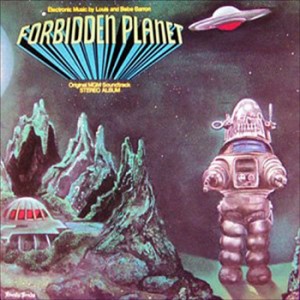
Tags: movies, science, science fiction
Posted in Sci-Fi, Science | No Comments »
February 8th, 2015
One evening, a Sufi stopped by the roadside to read a book. He lit a bright lamp then walked some distance away and lit a small candle. He sat by the candle and read. People passing by asked, “Why don’t you read by the lamp?” The Sufi replied, “The bright lamp attracts all the moths. Here I can read my book in peace.” (Adapted from A Perfumed Scorpion by Idries Shah)
Blockbuster books attract many readers, but I’m attracted by books that are almost forgotten. Here are a few favourite hidden gems:
- Till We Have Faces by C. S. Lewis retells the myth of Cupid and Psyche; and which Lewis called “far and away the best of my books.”
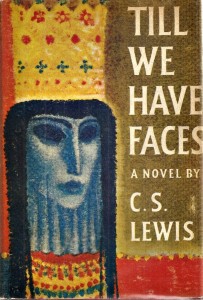
- Catastrophe, the strange stories of Dino Buzzati – a brilliant collection of surreal stories.
- Daydreamer by Ian McEwan – imaginative stories about a boy who daydreams to cope with growing up.
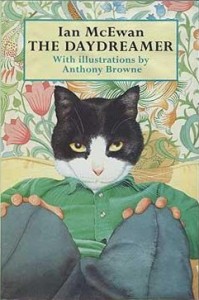
- The Importance of Living, by Lin Yutang – thoughts on everything by a Chinese writer and inventor
- Drift by William Mayne – survival story about a North American Indian girl and a white boy.
Tags: books, Reading, reviews
Posted in Book Reviews | No Comments »
February 1st, 2015
A Bee in a Cathedral by Joel Levy is a fascinating book of science analogies and astonishing numbers. Suitable for all ages, only the physics section is a bit complex. A few of my favourites factoids:
- Every day 1 million meteoroids strike the Earth
- How far to the nearest star, Proxima Centauri? Travelling in a rocket at 250,000km/h, it would take you 18,000 years
- Most of the living cells in your body are less than a month old
- About 50 million neutrinos are passing through you now
- Every molecule in a glass of water is changing partners billions of times a second.
- How hard does your heart pump blood? Empty a bathtub in 15 minutes using only a teacup —repeat this without stopping for the rest of your life
- If an atom were blown up to the size of a cathedral, the nucleus would be no larger than a bee buzzing about in the centre.
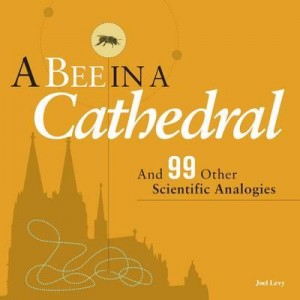
Tags: books, honey bees, reviews, science
Posted in Bees, Book Reviews, Science | No Comments »
January 18th, 2015
The things that you do should be things that you love; and the things that you love should be things you do. – Ray Bradbury
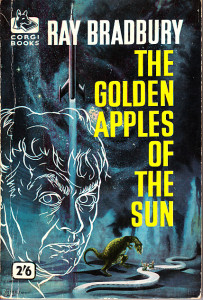 Ray Bradbury’s stories kept me reading in my teenage years and still inspire my writing today. I still have my first Corgi paperback of The Golden Apples of the Sun – the best 65c I ever spent (in 1970 that was an hour’s raspberry picking). Bradbury’s sci-fi-fantasy stories are scary, surprising, sentimental, and highly imaginative: a dinosaur falls in love with a lighthouse (The Fog Horn); an insect changes history (A Sound of Thunder); an astronaut pursues Jesus from planet to planet (The Man); the sun only shines once every 7 years (All Summer in a Day). He wrote short stories (my favourite collection is The Illustrated Man), novels, film (eg. Moby Dick) and TV.
Ray Bradbury’s stories kept me reading in my teenage years and still inspire my writing today. I still have my first Corgi paperback of The Golden Apples of the Sun – the best 65c I ever spent (in 1970 that was an hour’s raspberry picking). Bradbury’s sci-fi-fantasy stories are scary, surprising, sentimental, and highly imaginative: a dinosaur falls in love with a lighthouse (The Fog Horn); an insect changes history (A Sound of Thunder); an astronaut pursues Jesus from planet to planet (The Man); the sun only shines once every 7 years (All Summer in a Day). He wrote short stories (my favourite collection is The Illustrated Man), novels, film (eg. Moby Dick) and TV.
Read more about Ray Bradbury:
If you want to write, if you want to create, you must be the most sublime fool that God ever turned out and sent rambling.– Ray Bradbury
Tags: Ray Bradbury, science fiction
Posted in Reading, Sci-Fi | No Comments »
January 11th, 2015
Male bees (drones) have a decadent life inside the hive but it ends gruesomely. In spring and summer drones spend their days eating and sleeping – the female bees even clean up their droppings for them. In autumn the females push most of the drones out of the beehive to die in the cold air. Why have drones at all? To mate with a new queen, but it only happens once every few years. Several drones will mate with her and die in the act. Drones themselves have no father; they hatch from unfertilised eggs. It was once thought all bees came from virgin births, until in 1788 a blind Swiss naturalist, Francois Huber, proved that queens mated.
What big eyes the drones have; all the better to find the queen.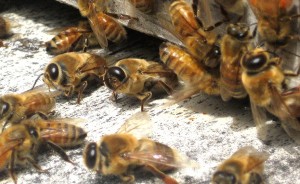
Tags: honey bees, science
Posted in Bees, Gardening, Science | No Comments »
January 4th, 2015
The book has long oscillated between being accepted as harmless hilarity and being condemned as excessively horrifying- Humphrey Carpenter
Struwwelpeter (Pretty Stories and Funny Pictures) by Dr Heinrich Hoffman (1845) is a classic of gleefully gruesome cautionary rhymes about naughty children. Hoffman was a psychiatrist who founded an influential Frankfurt asylum and pioneered counselling as an alternative treatment to cold baths. The characters in Struwwelpeter were inspired by his child patients – he’d tell them stories and draw pictures to calm them down. Hoffman was looking for a book for his three year old son and could only find ‘stupid collections of pictures, and moralising stories’, so he created Struwwelpeter. It was one of the first picture books designed purely to please children – before 1850 children’s books were mainly religious and moral lessons with titles such as An Exact Account of the Conversion, Holy Lives and Joyful Deaths of Several Young Children. Read more about ‘Shock-Headed’ Peter here.
The Awful Warning carried to the point where Awe topples over into helpless laughter.– Harvey Darton

Tags: children's books, picture books, reviews, struwwelpeter
Posted in Book Reviews, Children's Books, Humour, Reading | No Comments »
December 21st, 2014
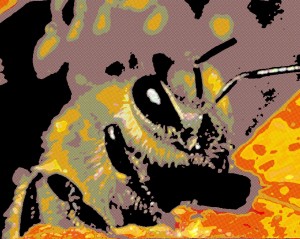
Honey bees have six (girl) powers to match any comic-book super hero. And like every super hero bees have one fatal weakness: when a bee stings you, it dies.
1. Super Flyers
Like Superman, bees are great flyers. A bee flies about 1000 km in her life. If she was human sized, that’d be like going five times around the planet. And she can carry 122 times her own weight.
2. Super Attractors
Like Magneto, honey bees use electro-magnetic forces. They have their own navigational GPS thanks to millions of magnetic crystals that sense the Earth’s magnetic field. Bees also have an electrical charge which attracts pollen.
3. Super Therms
Like Torch and Mr Freeze, bees cope with extreme temperatures. In the heat, air-conditioner bees fan their wings to cool the hive; and in the cold, bees huddle in a tight ball and shiver to keep warm.
4. Super Smarts
Like Professor X, bees are intelligent communicators. They are the only other creatures we know that use a symbolic language. The bee dance indicates direction and distance to flowers, and the quality of nectar. Bees can also tell time, measure, memorize, and solve problems.
5. Super Food
Like Wolverine, bees have healing powers. Honey is nutritious, lasts forever, and is a healer, killing bacteria and fungi. Manuka honey fights infection and heals burns. Bees use anti-bacterial propolis to keep their hives germ-free.
6. Super Transformers
Like Spiderman, bees can change their genetic structure. A queen bee is not born that way – any girl bee can become a queen. The worker bees prepare a royal baby by feeding it on royal jelly which triggers DNA change.
Tags: comics, honey bees, science
Posted in Bees, Science | No Comments »
December 6th, 2014
There is great exuberance in the Moomins, and a delightful battyness. – Jeanette Winterson
The Moomin comic strips by Tove Jansson (originally from the 1950s) are reprinted in five magnificent hardback volumes. The comics are a lovely balance of humour and optimistism. The free-spirited Moomins live in the moment and these comics are still relevant, commenting on consumerism, the environment and work. For example, in The Conscientious Moomins, an officer of the League of Duty admonishes Moominpappa for being a drop-out; but when Moominpappa joins the establishment, all the pleasure goes out of his life, and he returns to his old philosophy of
‘Live in peace, plant potatoes and dream!’
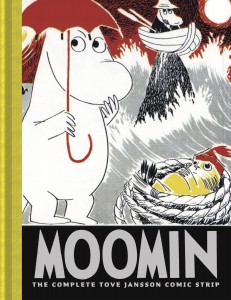
Tags: children's books, comics, moomins, reviews
Posted in Book Reviews, Children's Books, Humour, Peace | No Comments »
November 23rd, 2014
The Grey Lady and the Strawberry Snatcher is a classic picture book that almost didn’t make it. It took Molly Bang years to create and it was repeatedly rejected by publishers – they said it was ‘peculiar-looking’ and that ‘children won’t relate to an old woman as a protagonist’. The manuscript sat in a drawer for years, was re-worked and finally published to some critical reviews, writes Molly Bang: ‘The New York Times that said that the weird-looking characters and flashy colors were an indication that I was part of the drug culture and the detailed pictures told no real story but were merely an excuse to show off.’ Then it won a Caldecott award and everything changed. Why? It’s a one-of-a-kind, off-the-wall book, and very creepy! I love the tiny fungi that grow where the Strawberry Snatcher has trod.
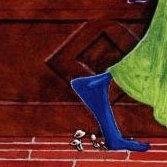
Tags: children's books, picture books, writing
Posted in Book Reviews, Children's Books, Writing | No Comments »
November 1st, 2014
I’m writing a sci-fi novel and falling into two traps: Infodump and Unobtainium.
Infodump is a when a character gives a mini lecture — telling instead of showing — such as in reply to “Tell me, Professor, how does your invention work?” Infodump can be reduced by editing out any techno-babble, and by using characters to give brief explanations only when plot demands it to move forward.
Unobtainium is a plot device such as an alien substance or a future technology. Most sci-fi has these but too often they’re used by writers to remove a plot hole; as in ‘Lucky I brought my sonic screwdriver to do this impossible task.’ (A version of: ‘Any sufficiently advanced technology is indistinguishable from magic’– Arthur C Clarke). Possible solutions are to make your ‘Unobtainium’ central to the plot (eg. give it a snappy back-story), or reduce it to a playful bit of science.
Tags: science fiction, writing
Posted in Sci-Fi, Writing | No Comments »
October 26th, 2014
Thousands of unarmed students in Hong Kong are currently standing up for democracy by taking to the streets. It’s often students who lead the way in peaceful protest movements:
- 1943: The White Rose group were university students in Munich who distibuted thousands of leaflets exposing the Nazis’ crimes and encouraging people to resist. They were executed.
- 1957: The Little Rock Nine were high school students in America who broke through the race barrier by enrolling in the local all-white high school despite threatening mobs.
- 1986-89: University students in China protested to demand more freedom, culminating in Tiananmen Square with half a million Chinese citizens. The government crushed the event.
- 1988: University students in Burma led massive street marches against the military rulers. The army killed hundreds but Burma eventually got free elections.
- 2000: Students in Serbia led a non-violent protest to help oust a corrupt government.
Tags: non-violence, Peace, people power, political change
Posted in Peace | No Comments »
October 5th, 2014
Posted in Uncategorized | No Comments »
September 13th, 2014
New genetic research suggests honey bees originated in Asia not Africa as previously thought. Bees have been around for a while: the oldest known bee is a 100 million year old bee suspended in a piece of amber (a tree resin), found in Myanmar (Burma). Ancient bees lived in trees or on cliffs – honey bees derived from cavity-nesting bees that spread out from Asia about 300,000 years ago. People discovered honey about 20,000 years ago; it must’ve seemed like a magical food in their diet of wild animals and plants. Early honey hunting was a dangerous job because bees lived in tall trees or on cliff faces. Cave paintings show hunters climbing cliffs to raid nests – imagine dangling from a vine, 150 metres up a cliff, while being stung by bees! People still do this kind of honey hunting today in India, Nepal, Malaysia and Indonesia.
Image: Rock painting of a honey hunter in Valencia, Spain (6000 to 8000BC)
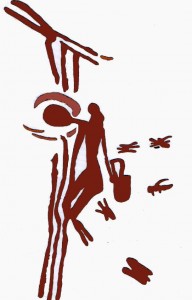
Tags: food, honey bees, science
Posted in Bees, Science | No Comments »
August 24th, 2014
The classic picture book Calico the Wonder Horse — The Saga of Stewy Stinker by Virgina Lee Burton was published in 1941. I adored this comic-book style cowboy adventure as a child mainly because of the bad guy. Stewy Stinker is so low he steals Christmas presents from children but in the end he repents. This picture of him crying out his rottenness always made me feel sorry for him:
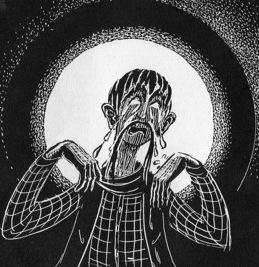
The word ‘Stinker’ was censored from the book in the 1940s as it was considered inappropriate for children. Burton was one of the great illustrators and the idea for Calico from seeing her sons engrossed with comic books. The wonderful design, cartoon framing and action scenes of Calico are worthy of a modern graphic comic: the flash flood and stagecoach crash are gripping highlights. But it’s that haunting image of Stewy that will stay with me.
Tags: children's books, picture books
Posted in Book Reviews, Children's Books | No Comments »
August 10th, 2014
Does the universe have a purpose or is it an accident? Scientists have divergent views on the significance of the universe. At one end of the spectrum is the iconoclast, Richard Dawkins, who sees an indifferent universe which has “precisely the properties we should expect if there is at bottom no design, no purpose.” At the other end is biologist Jane Goodall who believes the universe is both purposeful and meaningful. In between there are theories ranging from a ‘conscious universe’ to a ‘self-creating universe’. Whatever their beliefs, at least there’s usually a shared sense of wonder among scientists…
…Read the rest of my essay, Science and Soul, here.
 Photo: The remnants of supernova explosions, Puppis and Vela, birthplace of some of our atoms. Image courtesy of NASA/JPL-Caltech/UCLA
Photo: The remnants of supernova explosions, Puppis and Vela, birthplace of some of our atoms. Image courtesy of NASA/JPL-Caltech/UCLA
Tags: connections, consciousness, science, Universe
Posted in Science, Universe | No Comments »
August 3rd, 2014
The threat to nature is the same as that once posed by the notorious chemical DDT.– BBC News
A new study on ‘neonicotinoid’ pesticides says that they are a key factor in the decline of bees. The study combined 800 research papers from 20 years and concluded these nicotine-based nerve poisons are also damaging the wider environment. The pesticides are systemic – the whole plant remains toxic right through to flowering – so bees (and other critters) are poisoned by pollen, nectar, and drinking water. These pesticides are widely used in NZ and even sold in garden centres. The government has not yet responded to the new study, so meanwhile, avoid these products: Confidor, Advantage, Merit and Admire (what shameless names). And remember that there are ways to deal with pests without harming bees, including organic gardening and IPM:
It is high time we returned to Integrated Pest Management (IPM) – an approach focussed on minimising pesticide use, maximising the number of biological control agents, using cultural controls such as crop rotations, and monitoring pest numbers so that chemical controls only need be applied when there is a problem.– Prof David Goulson
Tags: Gardening, honey bees, pesticides, science
Posted in Bees, Gardening, Science | 1 Comment »
July 27th, 2014
I loved science fiction when I was a young teen – especially short stories about time travel, which usually had surprise endings. In Arthur C Clarke’s All the Time in the World, a man freezes time a second before a nuclear blast; in A Sound of Thunder, by Ray Bradbury, the death of an insect changes the course of history. I still have my old copy of Bradbury’s Golden Apples of the Sun; the Corgi paperback cost me 65 cents new in 1970 (about the hourly rate for raspberry picking in my summer holidays). A Wrinkle in Time by Madeleine L’Engle was a novel ahead of its time in 1960 (it was rejected 26 times by publishers). Its plot combines wormholes and angels and has a classic ending: a giant disembodied alien brain is defeated by love. L’Engle liked to tackle grand themes, as she said:
You have to write the book that wants to be written. And if the book will be too difficult for grown-ups, then you write it for children.
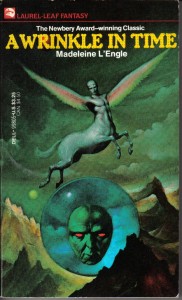
Tags: children's books, Ray Bradbury, science fiction
Posted in Book Reviews, Children's Books, Sci-Fi | No Comments »
July 19th, 2014
Honey bees and flowers have an electric relationship. A bee in flight becomes positively charged through friction with airborne particles. Fortuitously, flowers have a negative electric charge – and naturally, positive and negative attract each other. The bee (+) detects the tug of the flower charge (-) and lands on it. Immediately two things happen. Firstly, charged pollen leaps onto the bee’s body, a bit like your hair will leap onto a rubbed balloon. Secondly, the flower loses its negative charge – this tells nearby bees that this flower has just been visited. The flower has time to ‘recharge’ itself and refill its nectary. It’s a sweet friendship: bees get food (pollen, nectar) and flowers get pollinated.

Tags: honey bees, science
Posted in Bees, Science | No Comments »
May 31st, 2014
Old Tibet was once the essence of the mystical in Western eyes: with tales of mysterious Shangri-La and the yeti; the remote Himalayas; the serenity of Buddhism and its Dalai Lama. This essence has influenced many comic stories, such as wartime hero, Green Lama (1945), who got his strength by reciting a peaceful Buddhist mantra. Tintin (1958) experienced the power of Tibet when led by a vision to find a lost friend – even the Dalai Lama praised Tintin in Tibet.
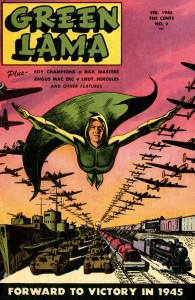
Old Tibet was no paradise but, sadly, the culture is fading fast. China invaded in 1950 and destroyed 6,000 Buddhist monasteries; and in 1959 the Tibetans rose up and thousands died. There’s since been a long struggle against the occupation – some Tibetans want independence, others (like the Dalai Lama) would settle for religious freedom and some autonomy.
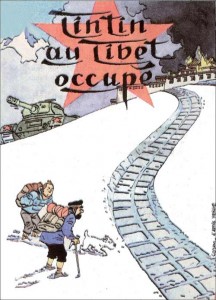
Tags: comics, tibet, Tintin
Posted in Book Reviews, Children's Books | No Comments »
May 9th, 2014
The first human-made beehives (clay and straw) date back 3000 years (to Israel). For centuries beekeepers melted the wax comb to extract the honey, forcing the poor bees to rebuild the comb every time. Then in 1851 pastor Lorenzo Langstroth designed a hive like a filing cabinet that could be used over and over. Young Mary Bumby introduced honey bees to NZ in 1839, bringing them on a ship from England. Today, over 3000 Kiwis are beekeepers, mostly hobbyists. Our parliament building is shaped like a straw hive called a skep. Skeps were enlarged by adding layers called ‘ekes’ – hence the saying ‘to eke things out’. Bees thrive in our cities but Council rules say that bees are ‘inappropriate in residential areas’ – but in many countries beehives are now kept in city parks. Now that our feral bees are extinct we need more city bees to pollinate our home gardens. Photo: apiary in a public park in Paris.
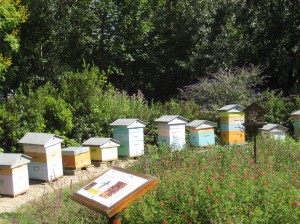
Tags: honey bees
Posted in Bees | No Comments »
April 22nd, 2014
‘There are moments, Jeeves, when one asks oneself, “Do trousers matter?”’
‘The mood will pass, sir.’
P.G. Wodehouse (WOOD-house) created a world without earthquakes, wars or dictators (except Roderick Spode whose ‘eye that could open an oyster at sixty paces’); where nothing mattered, except tidy trousers, and nothing broke, except engagements. He was a brilliant writer who cooked up similes like a master chef:
His legs wobbled like asparagus stalks.
She looked like a tomato struggling for self-expression.
Her face was shining like the seat of a bus-driver’s trousers.
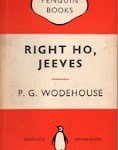 Wodehouse published 90 books, writing until his death at 93 years. When asked about his technique he said ‘I just sit at a typewriter and curse a bit’. All his books make me happy, but my favourite is Right Ho, Jeeves, about Bertie Wooster and his valet, Jeeves, who is ‘so dashed competent in every respect’. The chapter where Gussie Fink-Nottle presents the prizes at a private school is a great example of slow-building comedy.
Wodehouse published 90 books, writing until his death at 93 years. When asked about his technique he said ‘I just sit at a typewriter and curse a bit’. All his books make me happy, but my favourite is Right Ho, Jeeves, about Bertie Wooster and his valet, Jeeves, who is ‘so dashed competent in every respect’. The chapter where Gussie Fink-Nottle presents the prizes at a private school is a great example of slow-building comedy.
The sheer joy of stories which offer a world where things come right.– Sophie Ratcliffe (Wodehouse, Letters)
Read Stephen Fry’s tribute to P.G. Wodehouse.
Tags: books, humour, reviews, writers
Posted in Book Reviews, Humour, Writing | No Comments »
March 28th, 2014
This is a wonderful collection for children aged 8-12… Museums are hives of story, both real and imagined. These 22 authors have created new stories surrounding some intriguing objects from Te Papa Museum… Raymond Huber writes one of the most memorable stories in the collection, of a unique breed of humans who mature into insects (a highly original allegory). – Sarah Forster
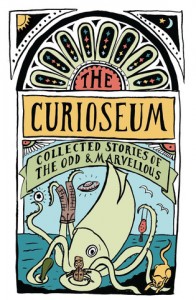
Tags: children's books, reviews
Posted in Book Reviews, Children's Books | No Comments »
March 17th, 2014
The classic sci-fi movie, The Incredible Shrinking Man (1958), was about the atomic angst of the 1950s and it’s themes have not dated. The hero is exposed to a radioactive cloud and begins to shrink. Trapped in his home, he battles his cat, a spider, and a leaking tap (always a threat to the male ego). Finally, he’s reduced to his essential self and ponders his place in the universe. This extract is from the closing monologue (script by Richard Matheson):
So close – the infinitesimal and the infinite. But suddenly, I knew they were really the two ends of the same concept. The unbelievably small and the unbelievably vast eventually meet—like the closing of a gigantic circle…
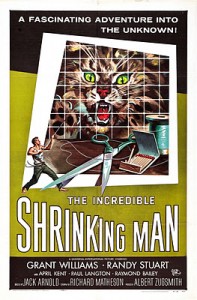
Tags: connections, movies, science fiction, Universe
Posted in Movies, Sci-Fi, Universe | No Comments »
February 27th, 2014
 Comics were banned in WW2 occupied France but Edmond-François Calvo secretly produced a powerful satirical comic that became a French icon after the Germans retretaed in 1944. La Bete Est Morte! is the story of the bloody European war told with Disney-style animal characters: with the French as rabbits; British bulldogs; and German wolves (Goebbels is a weasel, Himmler a skunk). La Bete Est Morte! is a forerunner of the brilliant graphic novel, Maus, with its Nazi cats and Jewish mice. Here’s an extract:
Comics were banned in WW2 occupied France but Edmond-François Calvo secretly produced a powerful satirical comic that became a French icon after the Germans retretaed in 1944. La Bete Est Morte! is the story of the bloody European war told with Disney-style animal characters: with the French as rabbits; British bulldogs; and German wolves (Goebbels is a weasel, Himmler a skunk). La Bete Est Morte! is a forerunner of the brilliant graphic novel, Maus, with its Nazi cats and Jewish mice. Here’s an extract:
My dear little children, never forget this: these Wolves who perpetrated these horrors were ordinary Wolves … They were not in the heat of battle excited by the smell of powder. They were not tormented by hunger. They did not have to defend themselves, nor to take vengeance for a victim of their own. They had simply received the order to kill.
Tags: books, children's books, comics
Posted in Book Reviews, Children's Books | No Comments »
February 22nd, 2014
Max and Moritz (1865) by William Busch is one of the world’s first comic books (actually, the Egyptians began the style in the pyramids). Two naughty boys create mayhem with booby-traps that torment animals and authority figures until the boys are finally punished (by ducks!) in keeping with the morals of the times. The exaggerated wickedness follows the style of Shock-headed Peter (1845).
Through the chimney now, with pleasure
They behold the tempting treasure.
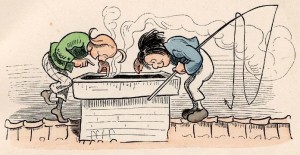
Busch was the first comic artist to use motion lines to show rapid movements, such as his eye-popping piano virtuoso playing furioso: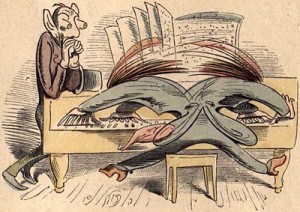

Tags: children's books, comics, humour
Posted in Children's Books, Humour | No Comments »

















